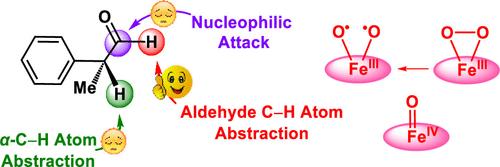单核非血红素铁(III)-过氧和铁(IV)-氧配合物的亲核与亲电氧化醛脱甲酰基化之争
IF 15.6
1区 化学
Q1 CHEMISTRY, MULTIDISCIPLINARY
引用次数: 0
摘要
高价铁(IV)-氧是转瞬即逝的中间体,在酶催化中起着重要的作用。相反,血红素和非血红素铁(III)-过氧中间体通常作为亲核试剂,在亲电氧化反应中转化为高价的铁-氧中间体。本文研究了含四甲基环环酮(TMC)类似物的铁(III)-过氧配合物对2-苯丙醛(2- ppa)及其衍生物的醛脱甲酰化反应,包括[FeIII(O2)(12-TMC)]+ (1), [FeIII(O2)(13-TMC)]+(2)和[FeIII(O2)(14-TMC)]+(3)。利用氘化底物,如α-[D1]-2-苯丙醛和醛-[D]-2-苯丙醛,证明了非血红素铁(III)-过氧配合物对2-PPA的脱甲酰基化是通过提取更强的醛C-H原子发生的,而不是预期的亲核攻击或更弱的α-C-H原子提取反应。有趣的是,在铁(IV)-氧配合物(即[FeIV(O)(13-TMC)]2+(4)和[FeIV(O)(N4Py)]2+(5)对2- ppa的脱甲酰基化过程中,仍保留了对醛类C-H原子抽象的偏好。DFT计算再现了反应性的实验趋势,并揭示了过氧化物O - O键被切割成铁(III)-二氧基,形成醛类C-H键抽象;这种化学选择性是通过稳定氧化剂和底物芳香环之间的非共价相互作用来实现的,这种相互作用使醛靠近feii - o2 /FeIV = O核心。这些新的实验和理论发现,加上之前对1-3在氢原子转移、氧原子转移和顺式二羟基化反应中的能力的证明,突出表明铁(III)-过氧核不是固有的亲核试剂,在化学和生物氧化反应中可以发挥更重要的作用,而不是作为高价金属-氧中间体的过渡物质。本文章由计算机程序翻译,如有差异,请以英文原文为准。

Debate of Nucleophilic versus Electrophilic Oxidative Aldehyde Deformylation by Mononuclear Nonheme Iron(III)-Peroxo and Iron(IV)-Oxo Complexes
High-valent iron(IV)-oxo species are fleeting intermediates that perform vital reactions in enzymatic catalysis. In contrast, heme and nonheme iron(III)-peroxo intermediates usually act as nucleophiles and are converted to high-valent iron-oxo intermediates for electrophilic oxidation reactions. Herein, we report a study on aldehyde deformylation reactions of 2-phenylpropionaldehyde (2-PPA) and its derivatives by iron(III)-peroxo complexes bearing tetramethylated cyclam (TMC) analogues, including [FeIII(O2)(12-TMC)]+ (1), [FeIII(O2)(13-TMC)]+ (2), and [FeIII(O2)(14-TMC)]+ (3). Reactivity studies by employing deuterated substrates, such as α-[D1]-2-phenylpropionaldehyde and aldehyde-[D]-2-phenylpropionaldehyde, demonstrate that deformylation of 2-PPA by the nonheme iron(III)-peroxo complexes occurs via abstraction of the stronger aldehyde C–H atom, rather than the expected nucleophilic attack or weaker α-C–H atom abstraction reactions. Interestingly, the preference for aldehyde C–H atom abstraction is retained during the deformylation of 2-PPA by iron(IV)-oxo complexes, i.e., [FeIV(O)(13-TMC)]2+ (4) and [FeIV(O)(N4Py)]2+ (5). DFT calculations reproduce the experimental trends in reactivity and reveal that the peroxide O–O bond is cleaved to form an iron(III)-dioxyl species that conducts aldehyde C–H bond abstraction; this chemoselectivity is achieved through stabilizing noncovalent interactions between the oxidants and the aromatic ring of the substrate that positions the aldehyde in close proximity to the FeIII–O2/FeIV═O cores. These new experimental and theoretical findings together with the previous demonstrations of the ability of 1–3 in hydrogen atom transfer, oxygen atom transfer, and cis-dihydroxylation reactions highlight that iron(III)-peroxo cores are not inherently nucleophiles and can have more important functions in chemical and biological oxidation reactions, rather than acting as transient species en route to high-valent metal–oxo intermediates.
求助全文
通过发布文献求助,成功后即可免费获取论文全文。
去求助
来源期刊
CiteScore
24.40
自引率
6.00%
发文量
2398
审稿时长
1.6 months
期刊介绍:
The flagship journal of the American Chemical Society, known as the Journal of the American Chemical Society (JACS), has been a prestigious publication since its establishment in 1879. It holds a preeminent position in the field of chemistry and related interdisciplinary sciences. JACS is committed to disseminating cutting-edge research papers, covering a wide range of topics, and encompasses approximately 19,000 pages of Articles, Communications, and Perspectives annually. With a weekly publication frequency, JACS plays a vital role in advancing the field of chemistry by providing essential research.

 求助内容:
求助内容: 应助结果提醒方式:
应助结果提醒方式:


